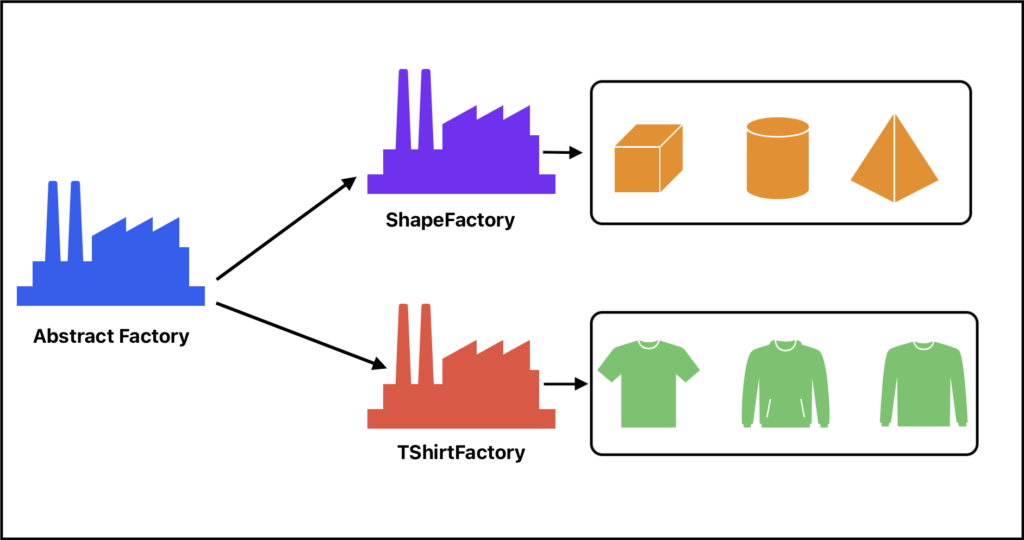Abstract Factory Design Pattern In Java, Purpose, Implementation, Pros & Cons
Definition
The Abstract Factory design pattern is a creational pattern that provides an interface for creating families of related or dependent objects without specifying their concrete classes.
In simpler terms, it defines a way to create groups of objects that belong together.

Purpose
- Abstract Factory defines an interface that specifies methods for creating different types of objects within a product family.
- Concrete factories implement this interface and provide the actual creation logic for specific product families.
- Client code interacts with the abstract factory, not knowing the concrete classes of the objects being created.
Problem Statement
Consider a scenario where your application directly creates UI elements (buttons, text boxes) based on the operating system (Windows, Mac). This approach presents challenges:
- Tight Coupling: Code is tightly coupled to specific element classes for each OS, hindering flexibility.
- Limited Extensibility: Introducing new UI elements or supporting additional OSes becomes complex.
- Maintenance Overhead: Changes to element creation logic require modifications in multiple code sections.
Solution: The Abstract Factory Symphony
The Abstract Factory pattern introduces two key components:
- Abstract Factory: Defines an interface that specifies methods for creating different product types within a family (e.g.,
createButton(),createTextBox()). - Concrete Factories: Implement the abstract factory for specific product families (e.g., WindowsUIFactory, MacUIFactory). These factories provide the actual creation logic for their respective UI elements.
Client code interacts with the abstract factory, requesting objects without knowing the concrete classes involved. This allows for switching between UI families seamlessly.
Implementation of Abstract Factory Design Pattern In Java

Java
// Abstract Factory Interface (UIFactory)
interface UIFactory {
Button createButton();
TextBox createTextBox();
}
// Concrete Factory (WindowsUIFactory)
class WindowsUIFactory implements UIFactory {
@Override
public Button createButton() {
return new WindowsButton();
}
@Override
public TextBox createTextBox() {
return new WindowsTextBox();
}
}
// Concrete Factory (MacUIFactory)
class MacUIFactory implements UIFactory {
@Override
public Button createButton() {
return new MacButton();
}
@Override
public TextBox createTextBox() {
return new MacTextBox();
}
}
// Product Interface (Button)
interface Button {
void click();
}
// Concrete Product (WindowsButton)
class WindowsButton implements Button {
@Override
public void click() {
System.out.println("Windows Button Clicked!");
}
}
// Concrete Product (MacButton)
class MacButton implements Button {
@Override
public void click() {
System.out.println("Mac Button Clicked!");
}
}
// Product Interface (TextBox)
interface TextBox {
void setText(String text);
}
// Concrete Product (WindowsTextBox)
class WindowsTextBox implements TextBox {
@Override
public void setText(String text) {
System.out.println("Setting Text in Windows TextBox: " + text);
}
}
// Concrete Product (MacTextBox)
class MacTextBox implements TextBox {
@Override
public void setText(String text) {
System.out.println("Setting Text in Mac TextBox: " + text);
}
}
// Usage Example
public class Main {
public static void main(String[] args) {
UIFactory factory = new WindowsUIFactory();
Button button = factory.createButton();
button.click();
}
}Pros and Cons
Pros
- Loose Coupling: The Factory pattern decouples the creation of objects from the code that uses them. This means the code using the objects doesn’t need to know the specific classes of the objects being created. This makes the code more flexible and easier to maintain.
- Encapsulation: The logic for creating objects is encapsulated within the factory class. This makes it easier to modify the creation process without affecting other parts of the code.
- Open/Closed Principle: New types of objects can be added to the system without modifying existing code. This is achieved by simply creating a new concrete factory class that implements the factory interface.
- Improved Readability: Factory methods can often have clear and descriptive names, making the code easier to understand.
Cons
- Increased Complexity: The Factory pattern can introduce additional complexity to the code, especially for simple cases where object creation is straightforward. This is because you need to create additional classes (factory and potentially concrete subclasses).
- Performance Overhead: In some cases, the Factory pattern can introduce a slight performance overhead due to the additional method calls involved in creating objects. However, this is usually negligible unless object creation is a critical performance bottleneck.
- Can be Overused: It’s important to use the Factory pattern judiciously. For simple object creation, it might be overkill.
When to Use the Abstract Factory Pattern:
The Factory pattern is a good choice when:
- Multiple Related Object Families Exist: Your application needs to work with distinct families of objects that are designed to be used together (e.g., UI elements for different platforms, data access layers for various databases).
- Consistency is Paramount: Ensuring objects within a family are created and used compatibly is crucial. The abstract factory enforces this by providing a central point for family-specific object creation.
- Flexibility is Desired: You anticipate the need to introduce new object families or platforms in the future. The abstract factory structure makes it easy to integrate these additions without modifying existing code.
When to Avoid the Abstract Factory Pattern
- Simplicity Reigns Supreme: You’re dealing with a limited number of object types and straightforward creation logic. The additional complexity introduced by the factory might be unnecessary.
- Performance is Critical: In scenarios where object creation performance is a bottleneck, the extra layer of abstraction might add a slight overhead. Evaluate if this overhead is significant in your specific context.
Real-Life Examples
- Automotive Industry: Different car manufacturers utilize abstract factory-like concepts to produce various car models based on a generic car creation process, with specific factories dedicated to different car types (e.g., sedan, SUV).
- Document Creation Software: A document creation application might leverage an abstract factory to create different document formats (e.g., Word, PDF) based on user selection. The factory ensures compatibility between document elements within each format.
- DocumentBuilderFactory: One of the notable examples of the Abstract Factory pattern implementation in Java libraries is the
javax.xml.parsers.DocumentBuilderFactoryclass. This class is part of the Java API for XML Processing (JAXP) and provides a way to obtain a parser that produces DOM (Document Object Model) objects from XML documents.
Use Cases in Selenium Web Automation
In Selenium web automation, the Abstract Factory pattern can be used to create web driver instances for different browsers (e.g., Chrome, Firefox, Safari).
A factory interface can define methods for creating web driver instances, while concrete factory classes provide specific implementations for each browser type.
Use Cases in API Automation Using Rest Assured
In API automation using Rest Assured, the Abstract Factory pattern can create different request specifications for API endpoints. Abstract factory interfaces can define methods for creating request specifications, while concrete factory classes provide implementations for different types of requests (e.g., GET, POST, PUT).
Relationship with Other Patterns
The Abstract Factory pattern interacts with other design patterns to create a more robust object-oriented design:
- Factory Method: The Abstract Factory pattern builds upon the Factory Method pattern by providing an interface for creating families of objects.
- Builder Pattern: When dealing with complex object creation with many parameters, the Builder pattern can be used in conjunction with the Abstract Factory pattern to create objects step-by-step.
- Singleton Pattern: The concrete factories in the Abstract Factory Pattern can be implemented as singletons.
- Composite Pattern: The Abstract Factory Pattern can be used to create complex composite objects that are composed of other objects.
Conclusion
The Abstract Factory design pattern provides a structured approach to creating families of related objects. It promotes loose coupling, improves code maintainability, and enhances flexibility in applications with multiple object families.
By understanding its purpose, strengths, and limitations, you can effectively leverage this pattern to create well-organized and adaptable object-oriented systems.





Post Comment